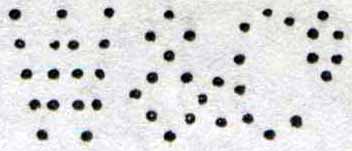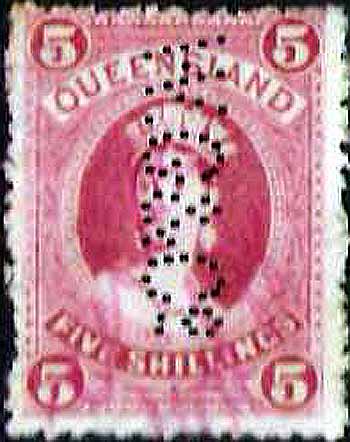|
Private Revenue Perfins of Queensland An Elsmore Coath production The authors would welcome your comments additions or input into this work
W -------------------------------------------------------- W&Co.a User: Webster & Co Warehousemen & Stationers Address: 75 Mary St, Brisbane, QLD Revenue Use: QV 1d (Qld state on 1897 four numeral). QV 1d (Qld Widow Weeds 1900). Rarity Scale: QV 1d (Qld state on 1897 four numeral) R4. QV 1d (Qld Widow Weeds 1900) R4. Background: Webster’s was formed by
brothers William and his younger brother Alexander
Webster. Both brothers were born in Scotland
but William was the first to come to Queensland. At
age 20 Alexander followed his brother travelling to
Melbourne in 1866 on the ill fated "Netherby" which
struck a reef off King Island in Bass Strait. On arrival in Melbourne Alexander
went to the goldfields in Victoria and later to the
rush in Gympie (Qld) before opening a store selling
mining supplies. After his time on the goldfields he
returned to England to be married but then returned
to Brisbane (via Hobart) and joined William, who was
by the early 1880’s a partner in the firm Webster,
Watkin & Co. and trading in wines and spirits.
Alexander obtained the agency from Alex Cowan &
Co. paper merchants (Scotland) and the firm became
known as Webster & Co.. They purchased premises
in Mary Street in 1885 and they maintained contracts
with the Queensland Government for paper and
stationary. During the 1880’s the business
expanded into general merchandise, shipping and
insurance and this required new premises in, George
Street, Stanley Street, West End and in Fortitude
Valley as well as a wharf, all in addition to the
factory in Mary Street. They also extended into
regional areas with outlets in Kent Street,
Maryborough; Quay Street, Rockhampton and Sturt
Street, Townsville. William died around the turn of the
century but Alexander took over until he died in
1923 aged 77. The company continued to trade until
just before World War 2. Device: Queensland postal records
show that the application for use of this device was
sought and approved in July 1898. The strikes we
have seen of the W&CO device indicate that it
was a single head device. Other sources have
reported usage from 1897 until as late as 1912 but
this is not supported by the postmark evidence that
we have seen. We have found usage from 1897 and
such usage pre dating the application is not
unknown, but the authors can find no usage later
than 1899. This short usage period is consistent
with the relative scarcity of the pattern on both
postage and revenue stamps. Given the size of the
user we would have expected that with a 15 year
usage period the pattern would have been much more
common. The device was almost certainly
located at the Mary Street address in Brisbane
rather than Webster’s other locations in Brisbane.
We can find no evidence for use of the device in the
Companies regional locations. Related Patterns: Nil -------------------------------------------------------- W.G&Co.a User: William Gardiner & Co Ltd Warehouse's Address: Cnr Albert & Elizabeth St, Brisbane, QLD (Further conformation of address needed) Revenue Use: QV (state issue on 1895, large chalon) 2/-, 2/6d, 5/-. QV (state issue on 2nd sideface) 1/-. Rarity Scale: QV (state issue on 1895, large chalon) 2/- R4, 2/6d R4, 5/- R4. QV (state issue on 2nd sideface) 1/- R4. Background: William Gardiner and Co
were warehousemen and they were headquartered in a
substantial building in York Street, Sydney. The
building had 8 floors with large internal lifts and
two street frontages, and the company also held an
adjoining property in Clarence Street. In addition
they had a buying office in London and offices and
representatives in Brisbane, Newcastle, West
Maitland and the Pacific Islands. In December 1926 they amalgamated
with fellow soft goods company, and perfin user,
Sargood Brothers to form Sargoods Gardiner Pty. Ltd.
The 71 York Street property was sold and the new
company moved into a building that Sargoods had in
construction at 24–26 York Street. Device: This device was located in
their Brisbane office and was a single head device. William Gardiner and Co applied to
the Post Office in NSW to use perforated stamps in
1888 but patterns from this the earliest of the W
Gardiner devices are not seen until 1894. William Gardiner and Co used a
range of small devices in there Sydney offices and
warehouse and all of these are found on both postage
and revenue stamps. These are dealt with in detail
in the NSW section. Only this pattern WG&CO is
also found used in Brisbane where it is found only
on revenue stamps of Queensland. It is difficult to say with any
certainty what happened with this device and how it
came to be used on revenue stamps of both New South
Wales and Queensland. Most likely the device moved
from the Sydney office and was relocated up to
Brisbane. We have noticed that the device was used
between 1894 and about 1900 + (approx) in NSW. Late
use in NSW shows some missing pins and it is notable
that the strikes on Queensland stamps are much
clearer. Also it seems that the set of fairly fine
pins were replaced by slightly thicker pins at the
same time that the device moved to Brisbane. The NSW WG/&/COLD.a and
WG/&/COLD.b devices are found used from very
early in the 20th Century about 1901 for
WG/&/COLD.a and a few years later for
WG/&/COLD.b. These may have been sourced as
replacements for the WG&CO device when it moved
to Brisbane. On the balance of probabilities the
authors believe that the WG&CO device was moved
from Sydney to Brisbane in the early1900's. The WG&CO pattern is found on
postage and revenue stamps of NSW and then later on
revenue stamps of Queensland. Related Patterns: Refer to other
William Gardiner and Co patterns in: NSW: WG/CO.a WG&CO.a
WG/&/COLD.a WG/&/COLD.b And Sargoods Gardiner patterns in: VIC: SB.a, SB.b, SBN.a, SG.a --------------------------------------------------------
© copyright 2011 |



